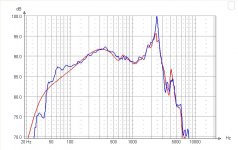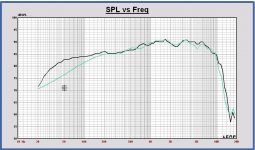Paul
Looking at your last simulation 800hz appears to be more concernent to reality. Also troels measured that baffle and he talked about a couple of db's boost. So you should consider that measure and it will be right.
Maybe the nasal sound I felt was due also to the tweeter
Looking at your last simulation 800hz appears to be more concernent to reality. Also troels measured that baffle and he talked about a couple of db's boost. So you should consider that measure and it will be right.
Maybe the nasal sound I felt was due also to the tweeter
Paul
Looking at your last simulation 800hz appears to be more concernent to reality. Also troels measured that baffle and he talked about a couple of db's boost. So you should consider that measure and it will be right.
Maybe the nasal sound I felt was due also to the tweeter
I will have a look at Troels site also. It will be for tomorrow.
I will look also to your design to improve it.
Maybe we can try the best design on target we can realize? And you listen to the result.
To have an audible effect, the edge rounding radius must be at least 4cm or so. 6cm would clear the ripple even if drivers are on the center vertical axis. I think it is too late for this as it would require a new baffle and custom rounding, the standard router bits I have seen go to a maximum of 1 1/2" (would still be ok).
If you like the 06 crossover, work around it by making small tweaks in the values until you find something that sounds good to you. The 18W driver would not have that "sparkle" you`re expecting, in the mid - this has to come from the tweeter.
If the "nassal" sound you describe sounds like you`re rubbing your finger to the cone, a very paperish sound, that is usually a resonanse of the paper cone. If you look at the manufacturer`s data sheet, there is such of about 3db at 2.1Khz and another one at 4.5Khz (more pronounced off-axis). A few db of paper cone resonanse can be enough to give you this paperish sound on some music passages. An excellent example of such sounding driver is the SB13PFC family.
Maybe it is worth trying to offset the second resonanse at 4.5Khz if Paul would want to try simulate a small cap across the woofer coil?
If you like the 06 crossover, work around it by making small tweaks in the values until you find something that sounds good to you. The 18W driver would not have that "sparkle" you`re expecting, in the mid - this has to come from the tweeter.
If the "nassal" sound you describe sounds like you`re rubbing your finger to the cone, a very paperish sound, that is usually a resonanse of the paper cone. If you look at the manufacturer`s data sheet, there is such of about 3db at 2.1Khz and another one at 4.5Khz (more pronounced off-axis). A few db of paper cone resonanse can be enough to give you this paperish sound on some music passages. An excellent example of such sounding driver is the SB13PFC family.
Maybe it is worth trying to offset the second resonanse at 4.5Khz if Paul would want to try simulate a small cap across the woofer coil?
Last edited:
That rising response up to 1Khz looks weird. 2.7mH should have cleared this. The 4 ohm version is dead flat with 1.35mH. What .FRD are you using with LEAP?
That rising response up to 1Khz looks weird. 2.7mH should have cleared this. The 4 ohm version is dead flat with 1.35mH. What .FRD are you using with LEAP?
The frequency response of the driver in the enclosure is simulated in Leap EnclosureShop. Leap has its own diffraction calculator.
But ... with this speaker there is a difference between the Leap simulation and other simulations and/or measurements of other projects. Leap simulates more boost at 800Hz for some reason.
In the past I have compared several Leap simulations with anechoic room measurements and own mls measurements, always with an almost perfect mapping of the measurement on the simulation.
@Cucicu
Is it possible that you measure your woofer without filter at 1m in your room at woofer height? You only have FFT measurement equipment? Not mls?
The only explanation I have at this moment for this difference, is that the cone model that Leap uses to calculate the diffraction is too much different from the cone of this Scanspeak driver. That should be the first one for me.
This issue has to be understood first, otherwise it has less sense to further use the Leap simulations for this project.
This is the SPL difference of the woofer without filter between a Leap simulation and a Zaph ZRT measurement for the same system.
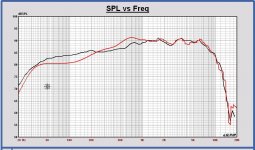
Leap in red ; ZRT in black
With the Infinite baffle response added
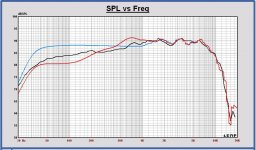
Leap in red ; ZRT in black ; infinite baffle response in blue
This difference is high. Some understanding is needed.
Who is right? I first go to sleep 🙂

Leap in red ; ZRT in black
With the Infinite baffle response added

Leap in red ; ZRT in black ; infinite baffle response in blue
This difference is high. Some understanding is needed.
Who is right? I first go to sleep 🙂
Hi paul, I hope you had a good sleep 🙂
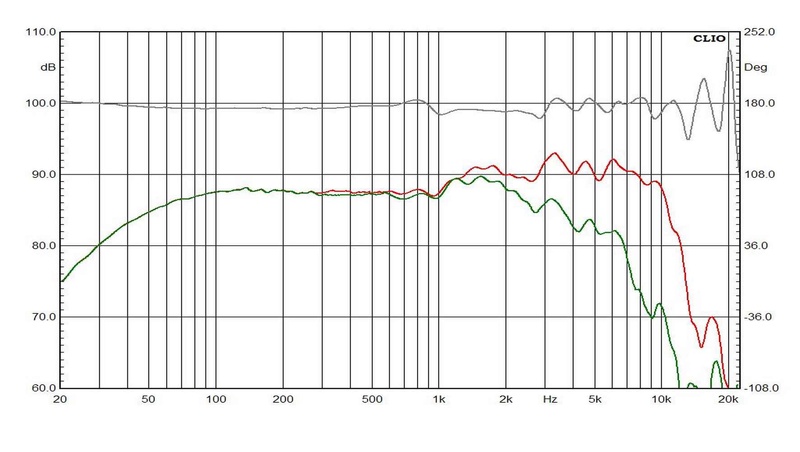
This is the measurement of the 18w8531g00 in half space. If you want I can send you .frd and zma files.
Which it looks like more similar?

This is the measurement of the 18w8531g00 in half space. If you want I can send you .frd and zma files.
Which it looks like more similar?
Last edited:
Here you find the measured FR by troels of 18w on ekta baffle. It s 22cm wide with major cuts of the angles on the top (for mid and tweeter) but it is substantially the same baffle of sp95.
P.s.
Paul, maybe you don t have set correct position for the 18w on baffle? Baffle is 95.5cm Height, 22.5cm wide and 24.4cm deep. Woofer is at the center orizontal position and 25cm height from top.
Looking at leap measurement seems that spl is not correct. In troels one, 800hz are under 90 db

P.s.
Paul, maybe you don t have set correct position for the 18w on baffle? Baffle is 95.5cm Height, 22.5cm wide and 24.4cm deep. Woofer is at the center orizontal position and 25cm height from top.
Looking at leap measurement seems that spl is not correct. In troels one, 800hz are under 90 db

Last edited:
Here you find the measured FR by troels of 18w on ekta baffle. It s 22cm wide with major cuts of the angles on the top (for mid and tweeter) but it is substantially the same baffle of sp95.
P.s.
Paul, maybe you don t have set correct position for the 18w on baffle? Baffle is 95.5cm Height, 22.5cm wide and 24.4cm deep. Woofer is at the center orizontal position and 25cm height from top.
Looking at leap measurement seems that spl is not correct. In troels one, 800hz are under 90 db
Thanks Cucicu.
The Troels measurement is almost the same as the Zaph one. You may post frd.
First I have to understand the differences between Leap and the posted measurements with this enclosure.
I did know about little deviations of Leap below 100Hz but not in the region 200-1000Hz. I didn't see these simulation-measurement deviations in previous projects. The measurements were done in a professional anechoic room, thus reliable measurements.
Ok.here we have tweeter and woofer files.
Attachments
Last edited:
Can you export them as .frd?
The last measurements I saw on the previous page (post 128) look too flat to be at 1m and there is no dip at around 150-180Hz (first floor reflection). They look very much nearfield. How did you do them?
The last measurements I saw on the previous page (post 128) look too flat to be at 1m and there is no dip at around 150-180Hz (first floor reflection). They look very much nearfield. How did you do them?
Can you export them as .frd?
The last measurements I saw on the previous page (post 128) look too flat to be at 1m and there is no dip at around 150-180Hz (first floor reflection). They look very much nearfield. How did you do them?
That is done by troels I think at 1mt.
Inside the zip file are .frd and .zma
Ok.here we have tweeter and woofer files.
Cucicu
The 18W8531 0deg response, you have posted, is an infinite baffle response, not free field, baffle response not included.
But no problem, I can scan myself if I need. Anyway Troels free field measurement, the plot you posted earlier, is almost the same as the Zaph one.
At first try to convince yourself about the SPL of your speaker by doing a measurement of your woofer (and tweeter also) in your cabinet without filter at 1m distance at woofer (tweeter) height.
And the best should be measuring outdoors and the bottom of the speaker at about 150cm height minimum. I do my outdoors control measurements in that way placing the speaker on a plank between two stepladders.
And the best should be measuring outdoors and the bottom of the speaker at about 150cm height minimum. I do my outdoors control measurements in that way placing the speaker on a plank between two stepladders.
At first try to convince yourself about the SPL of your speaker by doing a measurement of your woofer (and tweeter also) in your cabinet without filter at 1m distance at woofer (tweeter) height.
And the best should be measuring outdoors and the bottom of the speaker at about 150cm height minimum. I do my outdoors control measurements in that way placing the speaker on a plank between two stepladders.
If he lifts the speaker by placing it on the other speaker, he can usually get away down to about 180Hz which should be sufficient but best is as you have described. If he can enjoy some nice sunny Italian weather, best is to lift it up high outside and run a sweep.
Cucico, I will try your files later today and see if I can help. The files you have are not correct, do a measurement on the speaker itself, the published responses, as noted, are infinite baffle and not useful.
Last edited:
If he lifts the speaker by placing it on the other speaker, he can usually get away down to about 180Hz which should be sufficient but best is as you have described. If he can enjoy some nice sunny Italian weather, best is to lift it up high outside and run a sweep.
Cuccio, I will try your files later today and see if I can help.
Hi Mario,
Very good tip to place on speaker on the other.
Cucicu,
Try to do this measurement, already indoors, then you have the SPL of the drivers relative to each other. You can measure both on the same height position between woofer and tweeter.
And for me, it is again some feedback of a measurement. I think for 99% that Leap has a problem with this type of enclosure, but I need to know why. I will contact the Leap support group concerning this issue.
- Home
- Loudspeakers
- Multi-Way
- Scan-Speak crossover help
